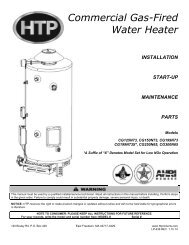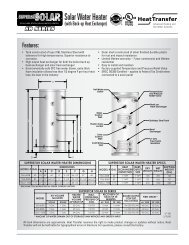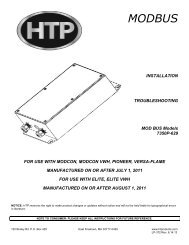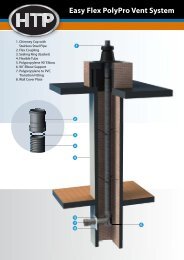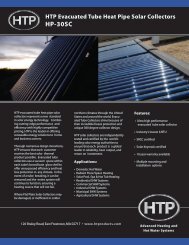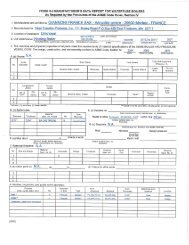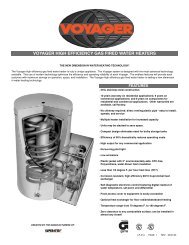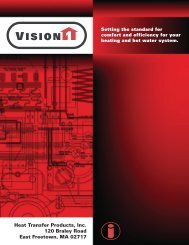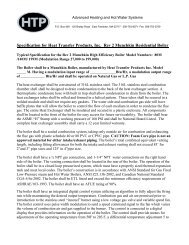MC Series Gas-Fired Circulating Heater - Heat Transfer Products, Inc
MC Series Gas-Fired Circulating Heater - Heat Transfer Products, Inc
MC Series Gas-Fired Circulating Heater - Heat Transfer Products, Inc
Create successful ePaper yourself
Turn your PDF publications into a flip-book with our unique Google optimized e-Paper software.
57<br />
B. FREEZE PROTECTION (WHEN USED)<br />
NEVER use automotive or standard glycol antifreeze, or ethylene glycol made for hydronic systems. System water, including additives,<br />
must be non-toxic, having a toxicity rating or Class of 1, as listed in Clinical Toxicology of Commercial <strong>Products</strong>. Use only freezeprevention<br />
fluids certified by fluid manufacturer as suitable for use with stainless steel heaters, verified in fluid manufacturer literature.<br />
Thoroughly clean and flush any system that has used glycol before installing the new heater. Provide heater owner with a material<br />
safety data sheet (MSDS) on the fluid used.<br />
1. Determine freeze protection fluid quantity using total system water content, following fluid manufacturer’s instructions. Remember to<br />
include expansion tank water content.<br />
2. NOTE: Local codes may require back flow preventer or actual disconnect from city water supply.<br />
3. When using freeze protection fluid with automatic fill, install a water meter to monitor water makeup. Freeze protection fluid may leak<br />
before the water begins to leak, causing concentration to drop, reducing the freeze protection level.<br />
C. FILL AND TEST WATER SYSTEM<br />
Ensure the heater is full of water before firing the burner. Failure to do so will damage the heater. Such damage IS NOT covered by<br />
warranty, and could result in property damage, severe personal injury, or death.<br />
1. Fill system only after ensuring the water meets the requirements of this manual.<br />
2. Close manual and automatic air vents and heater drain valve.<br />
3. Fill to correct system pressure. Correct pressure will vary with each application.<br />
a. Typical cold water fill pressure for a residential system is 12 psi.<br />
b. Pressure will rise when heater is turned on and system water temperature increases. Operating pressure must never<br />
exceed 25 psig.<br />
4. At initial fill and during heater startup and testing, check system thoroughly for any leaks. Repair all leaks before proceeding further.<br />
Eliminate all system leaks. Continual fresh make-up water will reduce heater life. Minerals can build up in the heat exchanger, reducing<br />
heat transfer, overheating heat exchanger, causing heat exchanger failure, and possibly resulting in property damage, severe personal<br />
injury, or death.<br />
5. The system may have residual substances that could affect water chemistry. After the system has been filled and leak tested, verify<br />
water pH and chlorine concentrations are acceptable.<br />
D. AIR PURGING PROCEDURE FOR HEAT EXCHANGER<br />
It is important that you purge the system of air to avoid damage to the heater. Make sure that this procedure is followed before firing the<br />
heater.<br />
The heater must be room temperature before attempting to purge air from the heat exchanger purge valve. The supplied tubing is rated<br />
to 120 o F maximum.<br />
The control system allows the installer to run the heater pump and indirect pump manually to assist in purging air from the system. This<br />
feature, in combination with the supplied purge hose and fitting on the heat exchanger, will help to remove air from the heat exchanger<br />
and hydronic piping system.<br />
To remove air from the system, follow the steps listed on the following page:<br />
Open manual air vent BY HAND ONLY! Use of tools, such as wrenches or pliers, can snap or crack the valve. NOTE: This damage IS<br />
NOT COVERED BY WARRANTY!<br />
LP-171 Rev. 10.2.13



